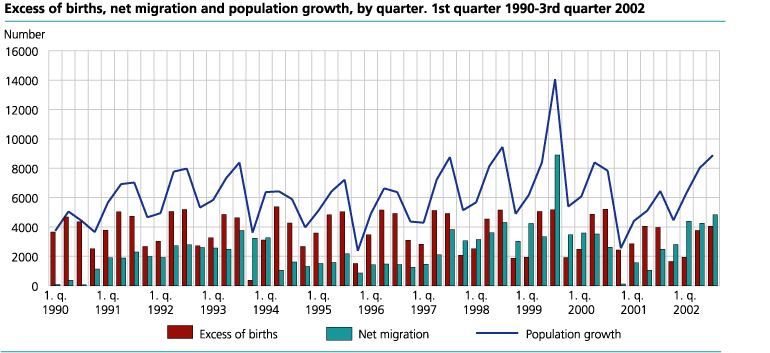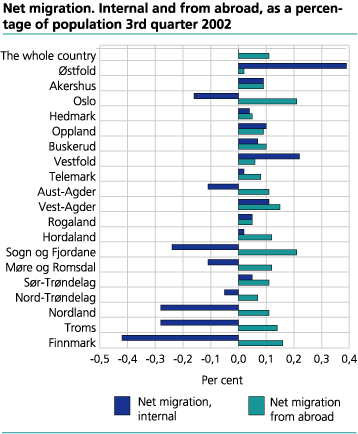Content
Published:
This is an archived release.
Excess of births below 10 000
For the first time since 1987 excess of births - births minus deaths - is lower than 10 000 for the first nine months of 2002. So far this year the birth surplus is 9 700, down 1 100 compared to the same period last year.
In 1987 the excess of births was only 7 600, while it peaked in 1996 at 13 600.
The natural increase is decreasing, and the reason is the reduced number of newborns. From 1 January 2002 till 1 October 2002 42 600 children were born, 1 300 less than in 2001. The number of deaths is relatively stable, 32 800 deaths so far this year.
Net migration increases to 13 500
Net migration to Norway is approximately at the same level in the 3r d quarter of 2002 as in the two preceding quarters. The immigration and emigration figures for the period 1 January to 1 October 2002 show a migration surplus of 13 500 persons, an increase of 8 400 compared to the corresponding period in 2001.
So far this year 31 200 persons have moved to Norway, against 25 300 in the corresponding period last year. The figure for the first nine months of the year is thereby in the stratum of the peak years 1998, 1999 and 2000.
Asylum seekers who come to Norway seeking refuge are normally included in the migration statistics only when they are granted asylum and receive a personal identification number. Those who are not allowed to stay are not included in the statistics. It may take a while before a group of asylum seekers is reflected in the migration figures, due to the handling time before residence is granted. Therefore, the variation in the migration figures does not give an exact picture of the variation in the in-flow to the country, but rather the variation in residence permits granted. Reductions in handling time at The Directorate of Immigration probably influence the immigration figures for 2002.
Emigration from Norway, at 17 700 so far this year, is lower than the corresponding figures for 2001. The difference is 2 500. The figures for 2001 reflect the return of Kosovo-Albanians to Yugoslavia, and the emigration figure for the 1s t-3r d quarter 2002 is back at the level of the late 1990's.
Asian citizens make up half the immigration surplus
Asian citizens make up almost half of the migration surplus to Norway till now the year. Of a net migration of 6 300 2 100 are Iraqi citizens. In the same period last year the number was approximately 700 for the Iraqis. Afghan, Thai and Iranian citizens constitute the other big groups from this region.
Russians, Germans, Turks and Poles are the groups with the largest immigration surpluses among European citizens. Yugoslavian citizens are also a main group of immigrants, but in this group an almost equal number leaves Norway. Swedish, Danish and Finnish citizens have the largest numbers of immigrations. At the same time they also have equally high numbers of emigrations so far in 2002.
Norwegian citizens move in and out of Norway too, the figures are 7 600 and 8 400 respectively so far this year. This results in a net emigration flow of about 900 people, 600 less than the same period last year.
Somali citizens are the main group immigrating from Africa, as has been the case yearly since the late 1980's. The total immigration surplus from Africa was 2 600 for the first nine months of the year, against 1 600 in 2001.
4 547 000 inhabitants
The immigration surplus is the main reason the population increase (that is, excess of births plus net migration) has risen from 16 000 for the first nine months of 2001 to 23 200 for the same period this year. Per 1 October 2002 the preliminary total population figure is 4 547 300 residents.
The statistics is published with Population.
Contact
-
Statistics Norway's Information Centre
E-mail: informasjon@ssb.no
tel.: (+47) 21 09 46 42


